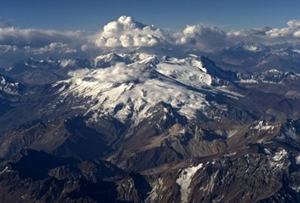UAlbany Scientist is Reconstructing Thousand-Year History of the South American Summer Monsoon
.jpg) |
|
Associate Professor Mathias Vuille, internationally renowned for his study of retreating glaciers in the Andes. (Photo by Mark Schmidt) |
ALBANY, N.Y. (August 8, 2013) – University at Albany atmospheric scientist Mathias Vuille is leading a team of scientists in producing the first comprehensive 1,000-year climatological history of the South American summer monsoon (SASM). The study will help the continent forecast and prevent massive destructiveness from droughts and floods.
Vuille, an associate professor in the Department of Atmospheric and Environmental Sciences, is internationally renowned for his study of retreating glaciers in the Andes. He and his research team will reconstruct the SASM history using ice core data from the Quelccaya Ice Cap in the Peruvian Andes to learn more about the envelope of natural monsoon variability. The work is supported through a $512,000 grant from the National Science Foundation (NSF).
The SASM is of great socioeconomic relevance to sub-tropical South America, delivering water for ecosystem integrity and human activities including agriculture, sanitation, hydropower production and many other socioeconomic purposes. Year-to-year variations in monsoon strength, and onset and demise dates have been linked to drought and floods and can cause widespread economic damage.
 |
|
Using ice core data from the Quelccaya Ice Cap, shown here, Mathias Vuille's team will learn more about the envelope of natural monsoon variability that greatly impacts South America. |
There is little known about how the SASM has varied in the past and how it responds to natural (volcanic or solar) and man-made (aerosols and greenhouse gases) disturbances. Using onsite data sets combined with isotope-enabled model simulations for the past millennium, the scientists will develop a “forward model” that allows reconstructing monsoon variations upstream over the Amazon basin since the year 850 AD.
The Quelccaya site was chosen because approximately 85 percent of all snowfall is associated with the SASM. Quelccaya also contains a long, high-resolution and precisely-dated ice-core record and has been the focus of long-term onsite climatologic and glaciologic monitoring and calibration programs.
“Given the growing concerns over future changes in monsoon characteristics due to enhanced greenhouse gas concentrations, a better understanding of natural monsoon variability and its sensitivity to external forcing is absolutely essential,” said Vuille. He noted that the project’s progress will be documented on the Quelccaya blog website.
The project also includes additional educational aspects, such as the training at UAlbany of a graduate student and a postdoctoral research associate, and the integration of methods and results developed in the project into University undergraduate and graduate classrooms.
![]() For more news, subscribe to UAlbany's RSS headline feeds
For more news, subscribe to UAlbany's RSS headline feeds
A comprehensive public research university, the University at Albany-SUNY offers more than 120 undergraduate majors and minors and 125 master's, doctoral and graduate certificate programs. UAlbany is a leader among all New York State colleges and universities in such diverse fields as atmospheric and environmental sciences, business, education, public health,health sciences, criminal justice, emergency preparedness, engineering and applied sciences, informatics, public administration, social welfare and sociology, taught by an extensive roster of faculty experts. It also offers expanded academic and research opportunities for students through an affiliation with Albany Law School. With a curriculum enhanced by 600 study-abroad opportunities, UAlbany launches great careers.


